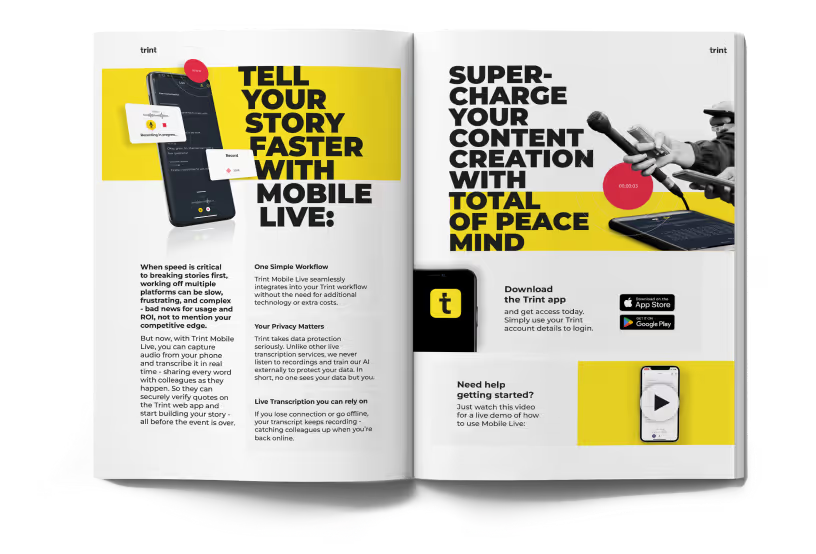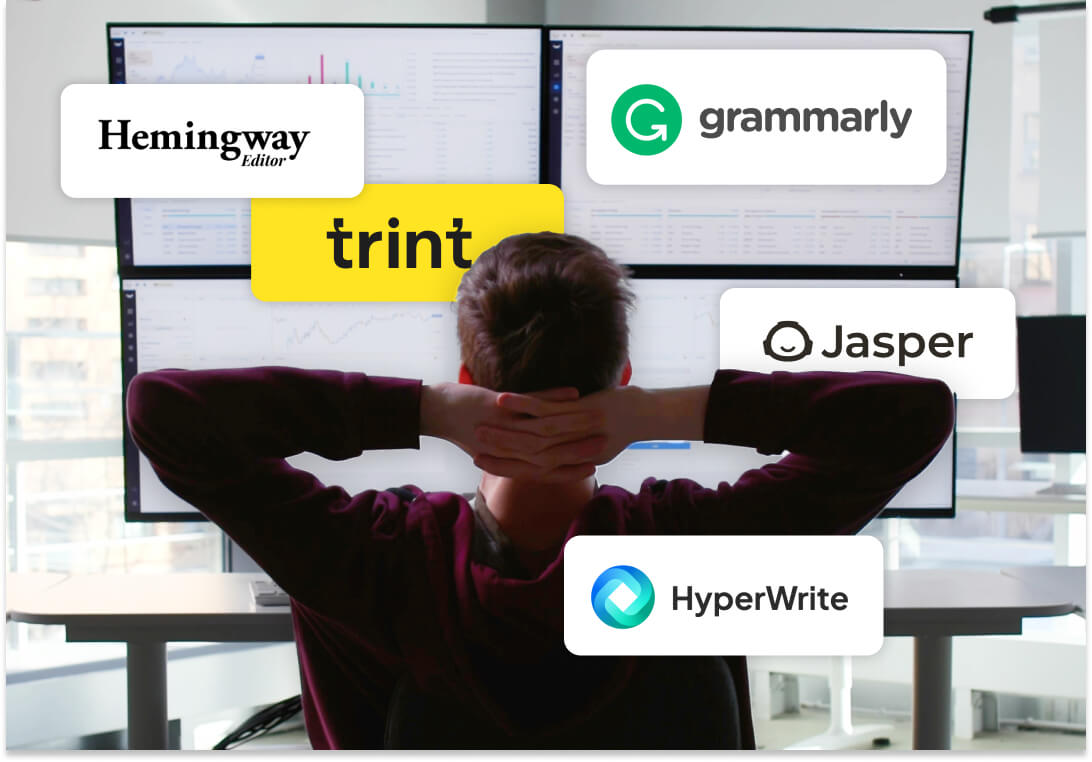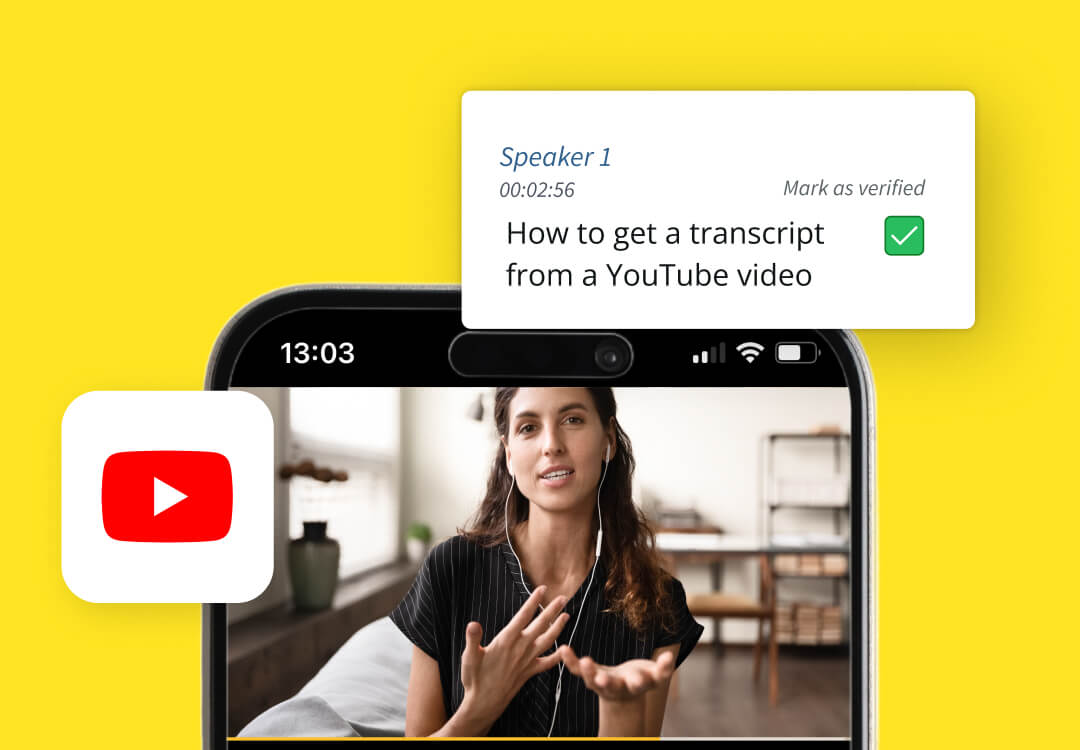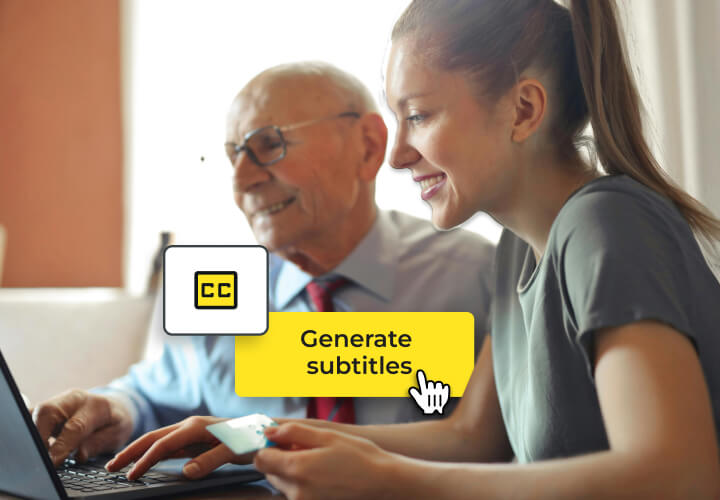
When they're not speaking to sources or typing up the latest breaking news story, journalists have a funny way of phrasing things. If you can't tell your dateline from your deadline or want to find out just what on earth 'banging out' is, you'll find all the answers in this glossary of essential journalism terms and newsroom jargon.
A
Above the fold
This term hails back to the newspaper days. Above the fold refers to content that appears at the top of a page. Back when physical newspapers dominated, they were typically folded in half on newsstands, with the most eye-catching stories showcased in the prime spot above the fold to grab attention. Today, the phrase describes web content that’s visible without scrolling, making it just as crucial for drawing in readers online.
Add
Short for 'additional', add copy is a journalism term that describes extra content that is added after the story has already hit the page or screen. Think a last-minute or follow-up quote, a breaking news update or a correction or clarification.
Algorithm
No longer just a buzzword in the software sphere, algorithms are key when it comes to online news. In short, they’re a set of rules that determine which stories to showcase by analyzing trends, reader engagement and relevance. While they help personalize your news feed, they also have a major influence on which stories grab the spotlight.
Angle
The specific focus or viewpoint of a story.
AP Style
Short for Associated Press Style, this is a standard set of writing guidelines used by journalists. It covers everything from punctuation, abbreviations and capitalization to formatting numbers, dates and titles. This ensures consistency and clarity across news outlets.
Attribution
Giving credit where it's due. It tells readers who said what, where the information comes from and why it matters. It's the lifeline of a story, adding credibility, depth and context while keeping the facts straight.
B
B-Roll
A broadcast news term. B-roll is supplementary footage that provides context or visual interest to the main story.
Banging out
When a journalist wraps up their last shift and heads out, their colleagues often give a loud send-off by banging their desks. It's an old, lively tradition that hails all the way back from the Fleet Street publishers — though why they did it is anyone's guess!
Beat
A beat is a journalist's specialty or niche that they cover regularly — think politics, sports, crime, or business. Journalists covering a specific beat will usually have in-depth knowledge and strong connections that help them deliver more insightful and impactful stories.
Below the Fold
The opposite of above the fold. Below the fold content refers to copy that is only visible after scrolling. This is usually where you'll find additional info on a story, or where less prominent stories are placed.
Bounce rate
The percentage of visitors who land on a news site or article and leave without clicking further. A high bounce rate often signals that readers aren't finding the content engaging or relevant enough to dive deeper. By analyzing bounce rates, journalists can tweak headlines, content and design to stop readers from hitting the exit button.
Breaking
Reporting on news in real-time, as it happens. Breaking news usually refers to urgent, high-impact stories like major political events, national disasters, or significant developments in ongoing investigations.
Thanks to recent technologies, news can be broken faster than ever before. Journalists out in the field can keep up with fast-paced stories using software like the Trint mobile app. They can instantly capture and transcribe audio right from their phone, then share it with their team on the go to get the story out without delay.
Broadcast
The distribution of audio or video content via radio, television or the internet.
Broadsheet
The term broadsheet used to refer to a large-format newspaper known for its broad pages. Now it generally describes any news site covering in-depth stories and providing analysis. Think major news outlets like The New York Times or The Wall Street Journal.
Byline
The author's name at the top of the article, usually under the headline.
C
Caption
A brief description or explanation that accompanies a photo to provide context, details or a narrative. A good caption should include who or what is depicted, when and where the image was taken, image credit and any other relevant details.
Circulation
The number of newspaper or magazine copies that land in readers' hands. In the digital age, circulation can be calculated by the unique visitors and page views your online publication racks up.
Column
A regular article or piece written by a specific writer (called a columnist), often opinion-based. Columns are usually placed in a fixed location within the publication, making them easy for readers to find.
Commentator
Someone who offers expert opinions and analysis on current events, trends or specific topics. They don't just deliver the facts but add their own sharp insights and opinions. While reporters stick to the who, what, when and where, commentators bring context, interpretation and a (usually) dash of personality to the mix. This helps to give a richer, more nuanced understanding of the news.
Copy
The written content of an article.
Copy desk
The department responsible for editing the copy before publication.
Copy Editor
A person responsible for reviewing and revising the copy for publication.
Correspondent
A journalist who reports from a remote location rather than the newsroom, often providing on-the-scene coverage. For example, a war correspondent reports directly from the front lines of a conflict.
Cover story
The spotlight article in a publication. It’s designed to be eye-catching and compelling, often covering a major topic, event or issue that the publication wants to highlight.
D
Dateline
A brief line at the beginning of an article that provides the date and location from where the story was reported — e.g. “NEW YORK, Aug. 10". It typically appears above the headline and helps establish context and credibility by showing the origin of the story.
Deadline
The time by which a journalist must submit their work.
Deck
Also called a lead, lede, subhead or standfirst. A smaller secondary headline that introduces additional context and offers more insight into the article’s content and angle. You'll often find the five Ws — the who, what, when, where and why — of the story covered in the deck or lede.
For example:
Headline:
City Council Approves New Park
Deck:
The new park will feature playgrounds, sports fields and walking trails, aimed at enhancing community recreation.
E
Editor-in-Chief
The top editor who oversees all editorial content in a publication. They're the ultimate decision-maker, steering the direction of the publication and setting the tone for every article, headline and feature.
Editorial
An article expressing the opinion of the editorial team or stance of a publication on a particular issue. Unlike straightforward news articles that aim to present facts objectively, editorials are opinion-driven and offer insight, analysis or a persuasive argument on current events.
Embargo
A set deadline that prevents the release of information until a specified time. This tactic keeps the scoop under wraps until the right moment, ensuring that everyone gets the big news at the same time.
Evergreen
A topic that stays relevant and valuable over time, unlike breaking news, which has a short shelf life. It's the classic, timeless stuff — like how-to guides, historical insights or in-depth features — that doesn’t age quickly.
Exclusive
A story or piece of information that a media outlet secures and publishes before any other news organization. Whether it’s a groundbreaking new report, a jaw-dropping interview or an inside scoop, exclusives give your story the edge over other coverage.
F
Feature
A long-form article focusing on a particular topic or story. It often has more of an in-depth narrative than straightforward news pieces, sometimes with a more emotional angle.
File
To submit copy to an editor ready to be published.
Filler
No publication wants their pages to look incomplete. Fillers are small, inconsequential articles or elements that are used to fill space. Listicles and good old-fashioned puzzles are common examples.
Fixer
A local journalist who helps a foreign correspondent arrange a story. Typical roles of a fixer include guiding a journalist around a location and arranging interviews. A fixer may even act as a translator if the journalist doesn't have any kind of translation software.
Freedom of Information Act
Established in 1967, the Freedom of Information Act (FOIA) gives the public the right to request access to certain federal agency records. The USA, Canada, and UK all have localized versions of this.
Freelancer
A journalist who works on a per-assignment basis rather than being employed full-time by one publication.
H
Hard news
News stories that focus on timely, highly consequential topics like politics, economics, crime and weather.
Headline
The title of an article which summarizes the main point.
Hold for orders
An article that is written in advance of an event.
Picture this. It's election night. The winner has just been announced and your go-to media outlet has released a fully written story within minutes. Ever wondered how? It's a type of article called 'Hold for Orders' (H.F.O) that's written in anticipation of a scheduled event and then put on hold until the time comes to publish it. Often, journalists will write up multiple versions covering each potential outcome so they always have the right one ready.
Human interest story
A story that focuses on people and their experiences, emotions and personal struggles.
I
Inverted pyramid
A writing style that places the most important information (the five Ws and one H) at the beginning. The middle of the story provides additional details that are helpful but not critical to the understanding of the piece. The final section covers more minor points, a conclusion or a call to action.
Investigative journalism
In-depth reporting aimed at uncovering the truth. Investigative journalism usually exposes some kind of wrongdoing like corruption, conspiracy or injustice.
L
Lead (Lede)
See deck.
Libel
The publication of a false statement that damages a person's reputation. It's written defamation, unlike slander, which is spoken words. Journalists can steer clear of libel by rigorously fact-checking, verifying sources and ensuring any published content doesn't unfairly damage someone's reputation. Bear in mind that libel laws differ from country to country, too.
M
Masthead
The section in a newspaper where the publication's details are listed. This includes the title of the publication plus a list of key editorial staff like the editor-in-chief, writers and designers.
N
News agency
An organization that supplies syndicated news to multiple publications. Also known as a wire service, a news agency is the engine room of the news world, collecting and feeding press releases, breaking news, images and more to publications. Associated Press is among the most notable examples, along with the world's oldest news agency Agence France-Presse (AFP). You can read more about AFP and how they use Trint in our case study here.
Nut graf/nut graph
A journalism term short for 'nutshell paragraph', the nut graf is a paragraph explaining the core of the story. It usually appears just after the lede.
For example:
Headline:
Local Bakery's "Pay It Forward" Campaign Sparks Community Spirit
Lede:
A small neighborhood bakery has become the talk of the town after launching a "Pay It Forward" campaign that has locals lining up to spread kindness, one pastry at a time.
Nut Graph:
What started as a simple idea to cover the cost of a few coffees has blossomed into a heartwarming movement that’s touched hundreds of lives. The bakery’s initiative is bringing people together and creating a ripple effect of generosity across the community.
O
Off-the-record
When a source shares information with a journalist but doesn't want it published or attributed to them. This allows sources to speak freely without fear of being quoted.
Op-ed
Short for 'opposite the editorial page'. An opinion piece usually written by someone outside of the editorial team.
P
Paywall
A system that restricts access to premium content on a website until readers pay for a subscription or one-time fee. It's a way for publications and editors to monetize their content.
Pitch
A proposal for a story, typically made by a journalist to an editor. To learn how to write up a killer pitch and share your story, make sure to read our guide on how to pitch a story to an editor
Podcast
An audio program available online for streaming or downloading. Podcasts are typically split into episodes and can cover everything from storytelling and serialized dramas to interviews. They can be produced by individuals, media companies or organizations and offer a flexible way for listeners to engage with content on the go. What to learn more? Read our tips for starting a branded podcast.
Press conference
A media event where newsmakers make statements and answer journalists' questions. Usually conducted by government officials, sports teams, police or celebrities.
Press release
An official statement given to journalists by an organization.
Pulitzer Prize
A prestigious journalism award. Established by newspaper publisher Joseph Pulitzer in 1917, the prize honors outstanding work in categories like investigative reporting, feature writing and commentary.
Pull-out quote
Also called a pull quote, this is a standout snippet from an article, often set in larger or stylized text, designed to grab attention and highlight a key point. The idea is to pull out a compelling or memorable line, making the content more engaging. Typically these quotes are carefully chosen for their impact, relevance or poignancy.
Pundit
An authoritative person who is often called upon to offer expert opinions and commentary on current events or specific topics. They’re the go-to voice for deep dives and thought-provoking takes on news and trends.
Q
Quotation (Quote)
The repetition of someone's spoken or written words within an article that is cited verbatim. They're used to add authenticity, provide evidence and give a voice to the article.
R
Retraction
A formal statement issued by a publication to correct or withdraw a previously published piece of information. This is usually done when the original content is found to be inaccurate or misleading. Retractions are vital for maintaining credibility and transparency.
Running story
A news story that is updated in real-time as fresh details emerge, usually during developing or ongoing events. A running story provides readers with the latest information and context. For example, a news outlet might have a running story on a major international crisis, with updates added as the situation unfolds.
S
Scoop
An exclusive story that a reporter or news outlet uncovers and breaks before anyone else. For example, if a journalist uncovers a major political scandal before others, that’s a scoop.
Shorthand
A system of rapid writing used by journalists to quickly transcribe spoken words during interviews or speeches. It uses symbols or abbreviations to effectively capture spoken content word-for-word. Thanks to innovative AI transcription software, shorthand isn't as essential to journalists as it once was. You can read our guide to shorthand to find out more about what shorthand is and how to write in it, as well as a few time-saving modern alternatives.
Sidebar
A shorter related story that accompanies a main article. It provides additional details, background info or a different perspective.
Suppose the main article discusses a major environmental policy change. The sidebar might feature an infographic detailing the policy’s impact, a profile of a key advocate or a historical overview of similar policies. This approach is designed to provide readers with a more immersive and comprehensive experience without overshadowing the main narrative.
Soft news
Stories that entertain or inform, like human interest and lifestyle pieces. Soft news is less urgent than hard news with less emphasis on breaking news or immediate events.
Sound bite
A term used to describe a short, catchy video or audio excerpt from a speech or interview. It's designed to be memorable and often used in broadcasts to highlight key points.
Source
A person or document that provides information or data for a story. Sources can be official, like press releases, or informal, like eyewitnesses or experts.
Staff Writer
A journalist employed full-time by a publication.
Stringer
A freelance journalist who contributes occasionally to a publication on an as-needed basis. They're not part of the official staff but are hired for specific assignments or to cover stories in their niche.
Style guide
A set of standards for writing and formatting used by a publication. It can encompass everything from spelling to formatting and design. Many news publications follow AP style but some newsrooms and publications choose to develop their own style guides.
Subhead/standfirst
See deck.
Syndication
The distribution of content across multiple media outlets. It allows articles, columns or features to be published in various locations beyond the original publication, reaching a wider audience.
T
Tabloid
A newspaper format that focuses on sensational news and entertainment. While tabloids can cover serious news, they typically present it in a more attention-grabbing, accessible style compared to traditional broadsheets.
Think piece
An opinion-driven article that explores a topic, issue or trend in depth. It's less about breaking news and more about providing insight, analysis or a fresh perspective, often reflecting the writer's personal viewpoint or interpretation.
Tip
A piece of information or lead provided to a journalist that may (or may not) lead to a news story. Tips usually, if not always, need further investigation to verify their validity.
Transcription
Converting spoken words, such as interviews or speeches, into written text. Transcriptions are written verbatim — right down to the "um"s and "ah"s. You can find out more by checking out our guide 'what is a transcript and what does a transcriber do?'.
Translation
The process of converting one language to another. Journalists often use a translation service to transcribe and translate an interview so that it can be understood by a wider audience. For example, a journalist covering an international conflict might translate interviews with local residents, eyewitnesses or government officials in their native language. Translation helps capture the raw, unfiltered voices from the heart of the story for readers everywhere.
U
UGC
Short for 'user-generated content', UGC refers to any form of content — such as text, videos, images, reviews or social media posts — created by readers or customers rather than brands or professional creators. In journalism, UGC adds flavor and authenticity to stories with real-world voices and firsthand accounts straight from the source. It's important for journalists to verify UGC before publishing.
V
Vox pop
A broadcast journalism term short for vox populi (meaning voice of the people). Vox pops are short video interviews with members of the public, typically used to gauge public opinion.
Y
Yellow journalism
Sensationalized or exaggerated news to attract readers. In the UK, yellow journalism is referred to as tabloid journalism. Think those magazines you see by the grocery store checkout.
Wrapping your head around journalism terms and newspaper terms can be a challenge. Keeping this glossary on hand will help you quickly navigate the lingo and stay on top of your game.
Want to supercharge your newsroom workflows and make researching, writing and publishing a breeze? Trint can transcribe video, audio and voice recordings to text with up to 99% accuracy. In just a few minutes you'll have a full transcript ready to review and edit. It's a must-have for any journalist's toolkit. Find out more about Trint for newsrooms and start your free trial or request a demo.

DON'T take our word for it
Download our eBook, Telling Stories Faster With Trint, and hear how Trint is making content creation faster, easier and, most importantly, painless for newsrooms across the world.
Download








